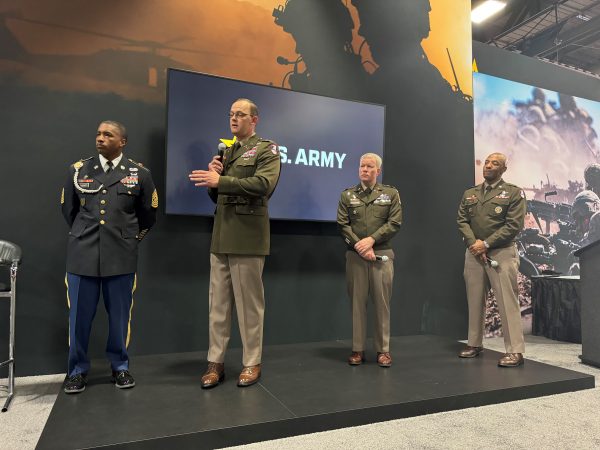“Our top priority is: How do we deliver that capability responsive to the warfighter?” said Lt. Gen. Sean A. Gainey, head of Army Space and Missile Defense Command, during the Association of the U.S. Army’s annual conference. “How do we continue to get after more tactical solutions that allow our Soldiers to maneuver around on a battlefield—different areas, different times, [with] smaller weight platforms.”
Col. Peter Atkinson, space division chief at Army Headquarters, said the Army is investing in new space-based gear for communications, intelligence, and position, navigation, and timing.
“This year, we started the fielding for mounted and dismounted assured PNT receivers,” Atkinson said. “And in [fiscal] ’25 we’re going to scale that across the Army, giving [Soldiers] the most capable, most reliant PNT receivers the force has seen.”
Atkinson said the Army is also “moving out” to provide Tactical Intelligence Targeting Access Nodes (TITAN) ground stations to enhance situational awareness and give Soldiers targeting data from satellites and high-altitude assets. And the Army is experimenting with new satellite communications terminals that will be able to connect to multiple satellite constellations, giving troops more options and increased reliability.
The Army effort mirrors similar programs elsewhere: The Space Force is seeking $228 million to fund research and development of its own hybrid SATCOM terminal in 2025, the Navy has a program called Satellite Terminal (transportable) Non-Geostationary, or STtNG, and the Air Force Research Laboratory is pursuing something called Global Lightning.
Lawmakers complained earlier this year that the military services need to better coordinate these efforts.
But Atkinson said the Army is working with the Space Force as it plans for new equipment.
“Everything we do is in partnership with Space Force,” he said. “We want to make sure that all of the efforts of Army Space are complementary. So we’re making sure to reduce any redundancy, duplicative efforts, and that’s been a major focus through the requirements process.”
The Army released its Army Space Vision for multi-domain operations earlier this year, including plans to increase its space specialists and to establish a new enlisted career field. That prompted a spirited debate with experts from the Mitchell Institute for Aerospace Studies, who argued in multiple op-eds that the Army is duplicating the Space Force’s effort, wasting resources, undermining cooperation, and favoring its own forces over joint capabilities.
At AUSA, Atkinson did not directly reference those critiques, but he did reiterate the Army’s case for keeping its own native space capabilities.
“It’s really important: Since the establishment of Space Force, what is the Army’s role?” Atkinson said. “It’s really critical for the Army to dominate on the land domain, to integrate multi-domain effects and multi-domain capabilities and … make sure that the warriors on the tactical edge have access to those capabilities.”

Col. Donald K. Brooks, commandant of the Army’s Space and Missile Defense Center of Excellence, said space-focused Soldiers are needed to ensure space capabilities are integrated into land forces to ensure warfighters have access to space capabilities on the battlefield.
“Army Space is land-centric, providing scalable, mobile, expeditionary and forward postured forces in contested and austere environments that are able to keep pace with maneuver forces in support of large-scale combat operations in the multi-domain environment,” he said.
“Our primary focus is to go forward into the theaters,” added Command Sergeant Major Maurice Tucker of the 1st Space Brigade.
The Army has held to this view since at least 2021, when Brooks, then commander of the 1st Space Brigade, told Air & Space Forces Magazine that if a unit has “roles and responsibilities at the tactical and operational level, I think it could be retained and should be retained.”
But Charles Galbreath and Jennifer Reeves, both retired colonels and now senior fellows at the Mitchell Institute, countered that argument in a September essay, saying it reflects an “underlying mindset … that if the Army doesn’t directly control it, they can’t trust it to deliver their desired effects.”
“While it is understandable that an Army commander would feel this way, this is the antithesis of joint integration at a time when no one service will ever fight by itself,” they wrote.
Brooks said the Army and Space Force continue to have a strong joint relationship. “We’re very complementary to each other, and how we fight across the tactical, operational and strategic levels of warfare, on the operational side and the institutional side as well,” he said.